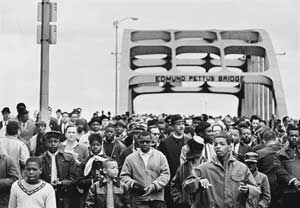
Follow workers.org on



RED HOT: TRAYVON MARTIN
CHINA,
AFGHANISTAN, FIGHTING RACISM, OCCUPY WALL STREET,
PEOPLE'S POWER, SAVE OUR POST OFFICES, WOMEN, AFRICA,
LIBYA, WISCONSIN WORKERS FIGHT BACK, SUPPORT STATE & LOCAL WORKERS,
EGYPT, NORTH AFRICA & MIDDLE EAST,
STOP FBI REPRESSION, RESIST ARIZONA RACISM, NO TO FRACKING, DEFEND PUBLIC EDUCATION, ANTI-WAR,
HEALTH CARE,
CUBA, CLIMATE CHANGE,
JOBS JOBS JOBS,
STOP FORECLOSURES, IRAN,
IRAQ, CAPITALIST CRISIS,
IMMIGRANTS, LGBT, POLITICAL PRISONERS,
KOREA,
HONDURAS, HAITI,
SOCIALISM,
GAZA



|
|
46 years later
Remembering ‘Bloody Sunday’
By
Dianne Mathiowetz
Selma, Ala.
Published Mar 13, 2011 10:50 PM
The grainy black-and-white images are horrifyingly familiar — a column of
Civil Rights marchers, numbering about 600, many dressed in their Sunday best,
faces so young, expressions so intent and serious, walking across the Edmund
Pettus Bridge in Selma, Ala., stopping before a wall of riot-geared state
troopers. Then a rush by the baton-wielding men in blue uniforms, muscling
their way into the waiting women and men who slowly retreat, turn to run, fall
and are trampled by the crowd and the horses of the mounted police. Then the
sounds of clubs hitting flesh and bone, people screaming, bodies hitting the
pavement; the sight of blood flowing, tear gas clouds obscuring the bodies, the
injured being hurried away.
These scenes from the March 7, 1965, march, better known as “Bloody
Sunday,” have become a standard television clip, a kind of media
shorthand whenever the Civil Rights Movement is referenced. What this portrayal
of the struggle for voting rights in a sound bite does, maybe deliberately, is
to distort the years of efforts by the Black population of Selma and the nearby
counties to register to vote. It ignores the heroic work of young volunteers
with the Student Nonviolent Coordinating Committee, starting in 1963, who faced
death by racist elements like the Ku Klux Klan for helping to prepare these
disenfranchised people to take Jim-Crow-required literacy tests.
It hides the firebombed houses, the loss of jobs, the beatings, the evictions
and the murder of Jimmie Lee Jackson, shot Feb. 18, 1965, in nearby Marion,
Ala. The 26-year-old Jackson was with his mother and grandfather during a
peaceful march to protest the arrest of Rev. James Orange, an organizer with
the Southern Christian Leadership Conference. The march was attacked by an
array of police agencies including Alabama State troopers. It was only this
past November that the Alabama State trooper who killed Jackson pleaded guilty
to this crime. James Bonard Fowler was sentenced to six months in the Perry
County jail.
The death of Jackson at the hands of an Alabama State trooper was the immediate
reason for the decision to march from Selma to the state capitol of Montgomery
on March 7, 1965. Some had wanted to carry his body on the 50-mile trek to make
it plain to arch-segregationist and then Gov. George Wallace that nothing was
going to turn them around. The march to the state capitol finally happened on
March 21, 1965. A commemorative march took place this March 6 on the 46th
anniversary of Bloody Sunday.
Every year since, these momentous acts of courage and determination are
commemorated in Selma with a re-enactment of the march across the Edmund Pettus
Bridge on the anniversary of Bloody Sunday. Many accompanying events serve to
educate and motivate, such as programs featuring the leaders and foot soldiers
of the Civil Rights Movement whose lives of activism reflect the ebbs and
flows, gains and losses of the struggle for equality and liberation. It is
their stories that add dimension and truth to the grainy black-and-white images
the corporate media show on Bloody Sunday.
Articles copyright 1995-2012 Workers World.
Verbatim copying and distribution of this entire article is permitted in any medium without royalty provided this notice is preserved.
Workers World, 55 W. 17 St., NY, NY 10011
Email: [email protected]
Subscribe [email protected]
Support independent news DONATE
|
|


